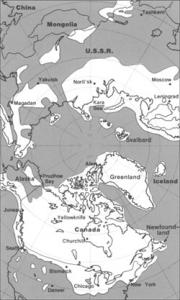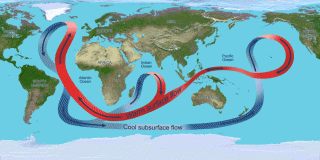Scientists' Explanation for Exploration 2
Greenland Ice Cores & Temperature Between 50,000 and 10,000 Years Ago
The data from the EPICA ice core samples provides evidence that temperatures can rapidly fluctuate. As you learned, the Milankovich Cycles are hypothesized to be a major cause of these changes. The data from the Greenland ice cores, however, show us abrupt changes on a different time scale and rate of change than what you observed in the Antarctica data. Scientists don’t think that these changes occurred for the same reason.
The Greenland data set not only shows us that temperature can fluctuate but that this change can happen abruptly. You just analyzed several examples of these abrupt changes and scientists think that one of the main causes is an alteration to the global ocean circulation.
One example of abrupt climate change is known as the Younger Dryas period, which happened about 13,000 years ago when the Laurentide ice sheet that covered much of Canada and the northern United States partly collapsed, dumping large volumes of freshwater into the North Atlantic Ocean. This rapid pulse made the North Atlantic waters less saline and therefore not dense enough to sink, disrupting the ocean’s thermohaline circulation. When this circulation is disrupted, the transport of warm water toward the North Atlantic is diminished, causing the northern Atlantic Ocean and nearby landmasses to cool.
This cold period is called the Younger Dryas because of the widespread distribution of the polar flower, Dryas octopetella, which thrives in extremely cold temperatures.
Changes in the Atlantic Ocean circulation are also likely the cause of the Dansgaard-Oeschger (D-O) events. These events, named for the Danish paleoclimatologist, Willi Dansgaard, and the Swiss climatologist, Hans Oeschger, were characterized by a sudden period of warming followed by a gradual period of cooling. Each D-O event lasted about 1,500 years. According to the Greenland ice core data, about 23 to 25 D-O events occurred over the last glacial period. Scientists theorize that large ice sheets periodically broke up and released an influx of freshwater in the North Atlantic, also causing a disruption to the thermohaline ocean circulation.
Between every 2 to 4 D-O events, the data show longer cooling intervals that represent distinct periods, known as the Heinrich events. Hamut Heinrich was a paleoclimatologist who found large amount of sediments on the North Atlantic ocean floor that had originated in Canada. Heinrich concluded that when the ice sheets covering Canada partly collapsed, a massive number of icebergs were released. Because of the cooler waters, icebergs were able to drift farther southward. As the icebergs melted, sediments that were frozen in the ice drifted to the ocean floor.
The last major glacial climate reached its peak about 20,000. At that time, glaciers of several kilometers in thickness covered large areas of Europe and North America, reaching as far south as New York and the Ohio River Valley. The temperatures in Greenland were 10°C (18°F) lower than today and tropical temperatures were 4°C (7°C) lower. Because so much water was in the form of ice over land, sea level was about 120 m (395 ft) lower than it was today. Scientists think that the last glacial period ended because two orbital cycles synchronized to cause warmer summers across the Northern Hemisphere.
About 18,000 years ago, the planet entered an interglacial (warming) period until about 13,000 years ago when the average temperature suddenly dropped and northeastern North America and northern Europe reverted back to glacial conditions (the Younger-Dryas period). About 11,600 years ago, the temperature in Greenland rapidly rose by 7°C (13°F) in a few decades, marking the ending of the Younger Dryas and the beginning of the Holocene epoch. For the past 8,000 years, the Vostok and Greenland ice core records indicate that Earth’s climate has been relatively stable.




